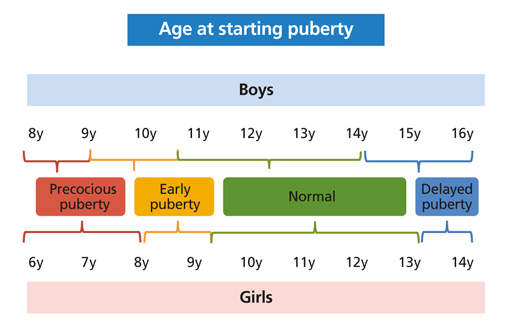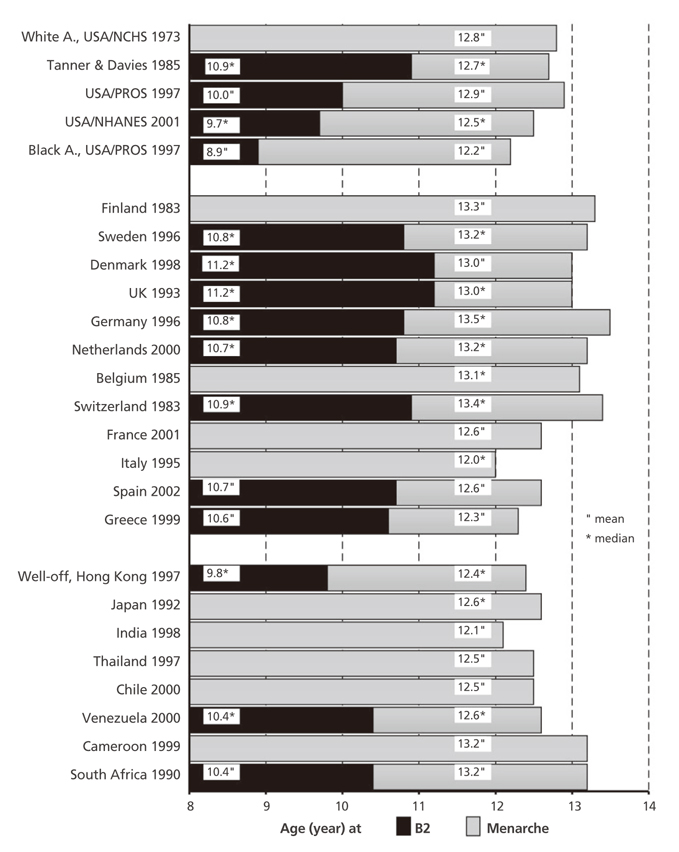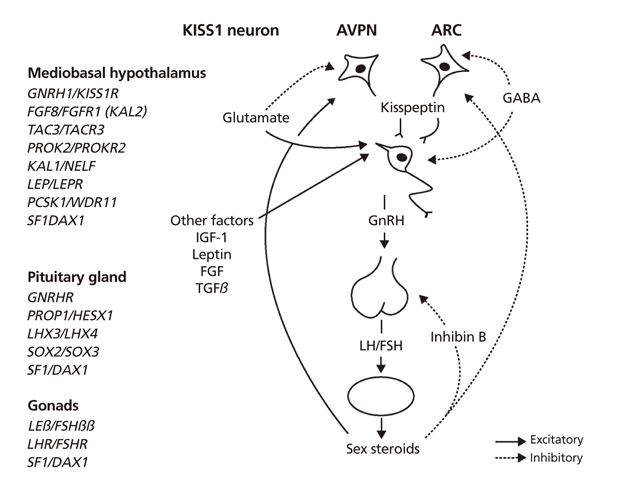J Korean Med Assoc.
2018 Oct;61(10):591-598. 10.5124/jkma.2018.61.10.591.
Etiology and treatment of central precocious puberty
- Affiliations
-
- 1Division of Endocrinology and Metabolism, Department of Pediatrics, Bundang Jesaeng General Hospital, Daejin Medical Center, Seongnam, Korea. odajulia@dmc.or.kr
- KMID: 2426482
- DOI: http://doi.org/10.5124/jkma.2018.61.10.591
Abstract
- The timing of pubertal onset is occurring at younger ages. This phenomenon is associated with many environmental factors such as sufficient nutrition, stress, many kinds of endocrine-disrupting chemicals, and genetic background. The loss of transcriptional repression induces kisspeptin release, resulting in pulsatile gonadotropin-releasing hormone secretion, which trigger pubertal onset. According to many reports, gonadotropin-releasing hormone agonists therapy for patients with rapidly progressive central precocious puberty is effective for improving final adult height. However, those results were obtained from the treatment of relatively young patients at earlier stages of puberty. A large cohort study investigating the environmental causes of precocious puberty as well as genetic factors is needed.
Keyword
MeSH Terms
Figure
Reference
-
1. Carel JC, Lahlou N, Roger M, Chaussain JL. Precocious puberty and statural growth. Hum Reprod Update. 2004; 10:135–147.
Article2. Parent AS, Teilmann G, Juul A, Skakkebaek NE, Toppari J, Bourguignon JP. The timing of normal puberty and the age limits of sexual precocity: variations around the world, secular trends, and changes after migration. Endocr Rev. 2003; 24:668–693.
Article3. Kaplowitz PB, Oberfield SE. Reexamination of the age limit for defining when puberty is precocious in girls in the United States: implications for evaluation and treatment. Drug and Therapeutics and Executive Committees of the Lawson Wilkins Pediatric Endocrine Society. Pediatrics. 1999; 104:936–941.
Article4. Park MJ, Lee IS, Shin EK, Joung H, Cho SI. The timing of sexual maturation and secular trends of menarchial age in Korean adolescents. Korean J Pediatr. 2006; 49:610–616.
Article5. Lee MH, Kim SH, Oh M, Lee KW, Park MJ. Age at menarche in Korean adolescents: trends and influencing factors. Reprod Health. 2016; 13:121.
Article6. Day FR, Perry JR, Ong KK. Genetic regulation of puberty timing in humans. Neuroendocrinology. 2015; 102:247–255.
Article7. Abreu AP, Macedo DB, Brito VN, Kaiser UB, Latronico AC. A new pathway in the control of the initiation of puberty: the MKRN3 gene. J Mol Endocrinol. 2015; 54:R131–R139.
Article8. Hagen CP, Sorensen K, Mieritz MG, Johannsen TH, Almstrup K, Juul A. Circulating MKRN3 levels decline prior to pubertal onset and through puberty: a longitudinal study of healthy girls. J Clin Endocrinol Metab. 2015; 100:1920–1926.
Article9. Busch AS, Hagen CP, Almstrup K, Juul A. Circulating MKRN3 levels decline during puberty in healthy boys. J Clin Endocrinol Metab. 2016; 101:2588–2593.
Article10. Pineda R, Aguilar E, Pinilla L, Tena-Sempere M. Physiological roles of the kisspeptin/GPR54 system in the neuroendocrine control of reproduction. Prog Brain Res. 2010; 181:55–77.
Article11. Choi JH, Yoo HW. Control of puberty: genetics, endocrinology, and environment. Curr Opin Endocrinol Diabetes Obes. 2013; 20:62–68.12. Silveira LG, Noel SD, Silveira-Neto AP, Abreu AP, Brito VN, Santos MG, Bianco SD, Kuohung W, Xu S, Gryngarten M, Escobar ME, Arnhold IJ, Mendonca BB, Kaiser UB, Latronico AC. Mutations of the KISS1 gene in disorders of puberty. J Clin Endocrinol Metab. 2010; 95:2276–2280.
Article13. Gianetti E, Seminara S. Kisspeptin and KISS1R: a critical pathway in the reproductive system. Reproduction. 2008; 136:295–301.
Article14. Fisher MM, Eugster EA. What is in our environment that effects puberty? Reprod Toxicol. 2014; 44:7–14.
Article15. Roa J, Garcia-Galiano D, Castellano JM, Gaytan F, Pinilla L, Tena-Sempere M. Metabolic control of puberty onset: new players, new mechanisms. Mol Cell Endocrinol. 2010; 324:87–94.
Article16. Pankov YA. Kisspeptin and leptin in the regulation of fertility. Mol Biol (Mosk). 2015; 49:707–715.
Article17. Kaplowitz PB, Slora EJ, Wasserman RC, Pedlow SE, Herman-Giddens ME. Earlier onset of puberty in girls: relation to increased body mass index and race. Pediatrics. 2001; 108:347–353.
Article18. Wang Y. Is obesity associated with early sexual maturation? A comparison of the association in American boys versus girls. Pediatrics. 2002; 110:903–910.
Article19. Teilmann G, Pedersen CB, Skakkebaek NE, Jensen TK. Increased risk of precocious puberty in internationally adopted children in Denmark. Pediatrics. 2006; 118:e391–e399.
Article20. Parent AS, Rasier G, Gerard A, Heger S, Roth C, Mastronardi C, Jung H, Ojeda SR, Bourguignon JP. Early onset of puberty: tracking genetic and environmental factors. Horm Res. 2005; 64:Suppl 2. 41–47.
Article21. Krstevska-Konstantinova M, Charlier C, Craen M, Du Caju M, Heinrichs C, de Beaufort C, Plomteux G, Bourguignon JP. Sexual precocity after immigration from developing countries to Belgium: evidence of previous exposure to organochlorine pesticides. Hum Reprod. 2001; 16:1020–1026.
Article22. Ozen S, Darcan S. Effects of environmental endocrine disruptors on pubertal development. J Clin Res Pediatr Endocrinol. 2011; 3:1–6.
Article23. Lomniczi A, Ojeda SR. The emerging role of epigenetics in the regulation of female puberty. Endocr Dev. 2016; 29:1–16.
Article24. Almstrup K, Lindhardt Johansen M, Busch AS, Hagen CP, Nielsen JE, Petersen JH, Juul A. Pubertal development in healthy children is mirrored by DNA methylation patterns in peripheral blood. Sci Rep. 2016; 6:28657.
Article25. Crowley WF Jr, Comite F, Vale W, Rivier J, Loriaux DL, Cutler GB Jr. Therapeutic use of pituitary desensitization with a long-acting lhrh agonist: a potential new treatment for idiopathic precocious puberty. J Clin Endocrinol Metab. 1981; 52:370–372.
Article26. Brauner R, Adan L, Malandry F, Zantleifer D. Adult height in girls with idiopathic true precocious puberty. J Clin Endocrinol Metab. 1994; 79:415–420.
Article27. Kwon EB, Lee SJ, Cha M, Kim SY. Changes in the predicted adult height after gonadotropin-releasing hormone agonist treatment in girls with idiopathic true precocious puberty. Ann Pediatr Endocrinol Metab. 2012; 17:160–168.
Article28. Jung MK, Song KC, Kwon AR, Chae HW, Kim DH, Kim HS. Adult height in girls with central precocious puberty treated with gonadotropin-releasing hormone agonist with or without growth hormone. Ann Pediatr Endocrinol Metab. 2014; 19:214–219.
Article29. Ahn SY, Yoo JH, Shin CH, Yang SW. The effects of gonadotropin-releasing hormone agonists on final height and its related factors in patients with true precocious puberty. Korean J Pediatr. 2004; 47:647–655.30. Kim HR, Nam HK, Rhie YJ, Lee KH. Treatment outcomes of gonadotropin-releasing hormone agonist in obese girls with central precocious puberty. Ann Pediatr Endocrinol Metab. 2017; 22:259–265.
Article31. Hong EJ, Han HS. Growth promoting effect of combined gonadotropin releasing hormone analogue and growth hormone therapy in early pubertal girls with predicted low adult heights. Korean J Pediatr. 2007; 50:678–685.
Article32. Park J, Kim JH. Change in body mass index and insulin resistance after 1-year treatment with gonadotropin-releasing hormone agonists in girls with central precocious puberty. Ann Pediatr Endocrinol Metab. 2017; 22:27–35.
Article33. Ko JH, Lee HS, Lim JS, Kim SM, Hwang JS. Changes in bone mineral density and body composition in children with central precocious puberty and early puberty before and after one year of treatment with GnRH agonist. Horm Res Paediatr. 2011; 75:174–179.
Article
- Full Text Links
- Actions
-
Cited
- CITED
-
- Close
- Share
- Similar articles
-
- Diagnosis and Treatment of Central Precocious Puberty
- Etiology and Age Incidence of Precocious Puberty
- Two Cases of Secondary Central Precocious Puberty in Boys with Congenital Adrenal Hyperplasia - before and after Treatment with Corticosteroid
- Central Precocious Puberty Following Treatment of Precocious Pseudo-Puberty Caused by Leydig Cell Tumor: A Pediatric Case and Literature Review
- Clinical Experiences of Precocious Puberty due to Neoplasms in Male Infants





